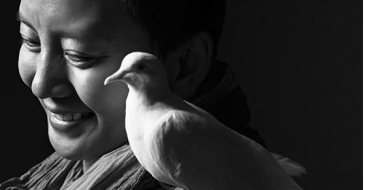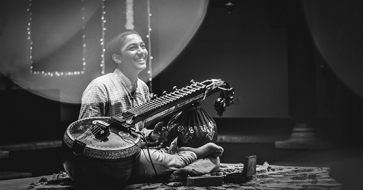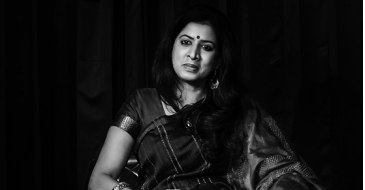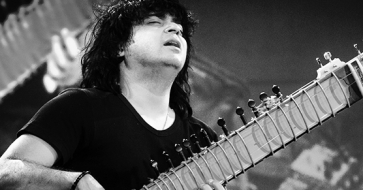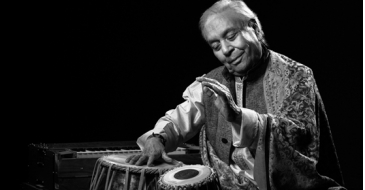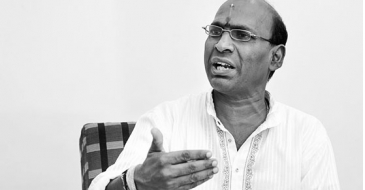How would you break down Konnakkol, the art form, for someone who has no idea of it?
Konnakkol is about vocalizing percussion. It is the skeleton of rhythm. You can add melody, dynamics, etc. to it and give life to the rhythm.
What is its purpose in the world of arts?
Konnakkol is one of the primary rhythmic languages. It can very easily reach the lay listener as well as the connoisseur. Once you have a certain level of expertise in Konnakkol, you can easily understand and pick up any other percussive form.
What is its purpose in life at large?
Like any other fine art, Konnakkol is very important in today's world because it can lead to peace and harmony. It can be used as an important medium of communication. It creates win-win situations unlike sports or war, where one side has to win and the other has to lose.
What does it mean to you personally?
It is my way of life. My life and music are inseparable. Whatever I do in my life is inspired by music and whatever I do in music is connected to what I do in my life. We breathe without realizing we do so. The same is the case for me with music.
How did Konnakkol happen to you?
My father, Sangeetha Vidyanidhi Dr B K Chandramouli and his guru Shri K S Gopala Rao are legends of mridangam and Konnakkol from my state of Karnataka. My dad used to say Konnakkol while playing his taniavartanam (percussion solo).
My father used to recite Konnakkol to me after I was born. Konnakkol was thus inside me even before I first touched my mridangam
He wasn't sure if I would learn from him seriously. So, he put me under the tutelage of Ganakalabhushana K N Krishnamurthy Sir when I was about five. Those days small sized mridangams were not available and the mridangams in my guru's house used to be the longer, lower pitched ones. I was a young boy and couldn't reach the two sides of the mridangam simultaneously to play on it. So, for about a year and a half, my guru taught me Konnakkol along with putting the tala (keeping time) so that I could memorize the lessons.
Did you know about other Konnakkol artistes at that time? Who inspired you?
My dad was my first inspiration. He used to encourage me to tell Konnakkol in his concerts. I was always attracted towards Konnakkol done by the legend Padmashri Sangeetha Kalanidhi Dr T K Murthy Sir. I remember listening to an audio cassette of his mridangam solo when I was very young where he starts with crystal-clear Konnakkol. It blew me away. My dad's style was one of improvising on-the-go while T K Murthy Sir employed a lot of set Tanjore patterns in his style which astounded me. I got a chance to listen to him live in Chennai in 1994 at a function organized by Shruti Laya Kendra of Karaikkudi Mani Sir where the who's who of the Carnatic percussion world were present in the audience. I immediately requested my friend, kanjira artist Shri B S Purushotham who had moved to Chennai then and was learning with Shri T K Murthy, to take me to his home. Murthy Sir was very welcoming. He agreed to teach me mridangam and said Konnakkol can be learnt automatically in the process.
Closer home, Sangeeta Kalarathna Bangalore Venkatram Sir and Ganakalashree Anoor Ananthakrishna Sarma Sir have encouraged me a lot. I have been very fortunate in my music journey to have been encouraged and inspired by many great musicians.
What is the role of individuality in saying Konnakkol?
Konnakkol is a highly individual art. You have to keep searching for new sounds and apply the dynamics and melodic concepts to it. You have to bring in variations in melody, intonation, etc. The same composition may sound different every time it is said or played because of the dynamics. You need to have a musical ear and know what to mix and in what proportion, just like when preparing a tasty meal.
If you ask two people to design the interiors of a house, they will come up with two different designs. Carnatic rhythms and Konnakkol work in a similar way. You have to study and understand traditional compositions to make sure you do not put the dining table in the toilet and the water closet in the kitchen
What went into making a style of your own?
In the early 2000s, people started using Konnakkol in a cliched way in their performances as a means to get applause. I didn't like that.
I have been exposed to a lot of sounds apart from Carnatic music like Jazz, Hindustani music, Sri Lankan music and African percussion. I have done a lot of studio recordings and have also performed across the world. Wherever I have gone, I have assimilated the sounds and used them to create patterns in my own way. For example, in my performances with contemporary dance productions, I began imbibing syllables from Kathak and Flamenco. Flamenco artistes create an atmosphere of tension and expectation with their audience every single time and go beyond just the beats and the numbers. I am trying to do something similar.
Is that a process of finding an identity of your own ?
Of course. Because I have discovered a lot of things. I think everything already exists in music. We just have to unearth it and compile it in our own way and in a sense, own it.
You've been going places with the Konnakkol. Can you share stories of how audiences respond to it?
Well, I am not the first one here. Ganakalabhushana TAS Mani Sir and Ganakalabhushana R A Ramamani Madam from Bangalore have conducted ensembles abroad featuring Konnakkol. I have watched recordings of their concerts in Germany where the audience would go crazy when the Konnakkol segment began and would look at the artistes as if they were Gods. That was when I started realizing the power of the art form. I then started using Konnakkol wherever I went and taught Carnatic percussion in conservatories in Amsterdam, Rotterdam, Belgium, Norway and Italy. When you teach the mridangam, you have to teach the fingering, the sound production, etc. and then the concept behind it all. With Konnakkol you can straightaway teach what is behind all of this, therefore making it easier for students.
Is it easier for people to connect with rhythm that is vocalised, in that sense?
Yes. It’s easier for people to comprehend and notate it when it is vocalized. Today you even find many vocalists posting rhythm videos on the internet. The other thing is eye contact. When I vocalize, I am looking at the audience. When I am playing it on the mridangam in a traditional Carnatic music setting, I am sitting at an angle that doesn’t allow much eye contact with the audience.
Is there scope for Konnakkol to cut across barriers and become a global sound?
I definitely think so. One of my students Somashekar Jois is trying to do that. He is inspired by the work done by the legendary Trichy Thayumanavar Sir in this space.
What does listening to Konnakkol demand from an audience? How clued in do they need to be?
Knowledge about Konnakkol is not a prerequisite for the audience. The performer has to keep the audience glued in.
How do you do that?
Getting the audiences' attention at the very beginning of a performance is not difficult. Sustaining that is the challenge.
You have to find your balance of speech, clarity and melody. It is like salt; you have other ingredients in your dish but it doesn't taste well unless it has the right amount of salt
At the same time, you have to create "oho" moments. An analogy would be eating good sweets on a festival day. The impact created stays till the next festival. However you can't stuff someone with too many of the same sweets. You have to find the right balance.
Just like how great musicians have done it, you have to develop your own style, understand what people like in you and move in that direction.

Your work has also travelled to different spaces and artistes; how have these experiences shaped your own craft?
My father taught me to be open to learning from anyone. Once we are open to learn from others, they will also learn from us. He also taught me to be liberal with sharing whatever I know. This has kept me in good stead. Whenever you share work, you begin to collectively own the project with a host of other musicians and as a result of that collaboration, the work can never fail. Everyone would have definitely grown as artistes, even if the project fails commercially. You analyze failures and mistakes together as one unit and not as individuals. This is my biggest learning from my experiences traveling and collaborating with other artistes.
The artistes I have worked with have been very generous in sharing their knowledge with me. They have taught me whatever they were doing with great patience. This has taught me to be more relaxed and to slow down for the sake of my art and for my own sanity. I used to be always in a hurry when I was younger. Not anymore. For that learning, I greatly value artists like Akram Khan; he has been among my key mentors.
What was it like to work with Akram Khan?
He is a true leader. There are so many elements in his production like music, dance, theatre, lighting, the sets and the costumes that all have to come together well for it to succeed. He has been able to extract the best from each one of us without ever commanding us to do so or being very demanding. When I first started performing with him in 2004, he told me to make sure I am noticed by the audience even if I play just one syllable. Being loud is not the criterion here. It is about getting the attention of the people. This means my body language and my attitude are also very important.
You've also been training people in Konnakkol; who can learn it?
Anyone. There are no pre-requisites. You just need to have the dedication, commitment and belief in the art form.
When I am teaching it, I go to the basic levels and start with arithmetic and single syllables. How I proceed further depends on the capacity of the student. I prefer a minimalistic approach; I teach one small thing and teach people how to exploit that and create multiple variations. I also use a lot of similes comparing it to daily life.
I have a student from Switzerland who joined me in January 2017. He didn't know anything about Indian music or rhythms back then. Today he can play a full mridangam solo in multiple nadais (gaits) and also recite and notate it. He can also point out if somebody plays it wrong.
How can they hone their craft?
The key thing is to practice and master any rhythmic pattern in the slow speed. Once you do that, speed comes naturally. Depending on one’s abilities, one may learn something in five minutes or take even 50 years.
People usually try to teach how to put tala (keep time) first. I follow the reverse approach – I usually teach them how to say the syllables and then teach them how to put tala and which beat comes along with which syllable. This has worked for a lot of students who have had no prior background to rhythmic patterns or tala.
How do you raise your own bar with the Konakkol? What is your practice routine with it?
If I have capacity to climb two steps, I think of four steps but not 10 steps. I challenge myself to reach just above my current level. If I am climbing a mountain, I will look a bit above my current eye level and try to get there. I will not look at the top right away.
Also, I never compare myself with anyone else. My capacity is God given and only he knows it. I only try to become a shade better than where I am today.
How has Konnakkol impacted your life?
My thought process has become much clearer. I can think fast. My anticipation skills have developed. I am able to better understand the psychology of people I perform for and with.
What sets a Konnakkol artiste apart?
Clarity of thought and effectiveness in the minimal time available.
What is the future of Konnakkol?
The future of Konnakkol is very bright. I see its applications in fields as diverse as medical healing. One of my students no longer stammers because Konnakkol has helped clear his speech. It can help people focus better. It can help multi-taskers compartmentalize their thoughts without mixing them up.
I am sure Konnakkol will increasingly become a key feature of many musical projects across the world. I hope to see this happen in my lifetime.
Interviewed by Ramkumar R
0 comments Comments





